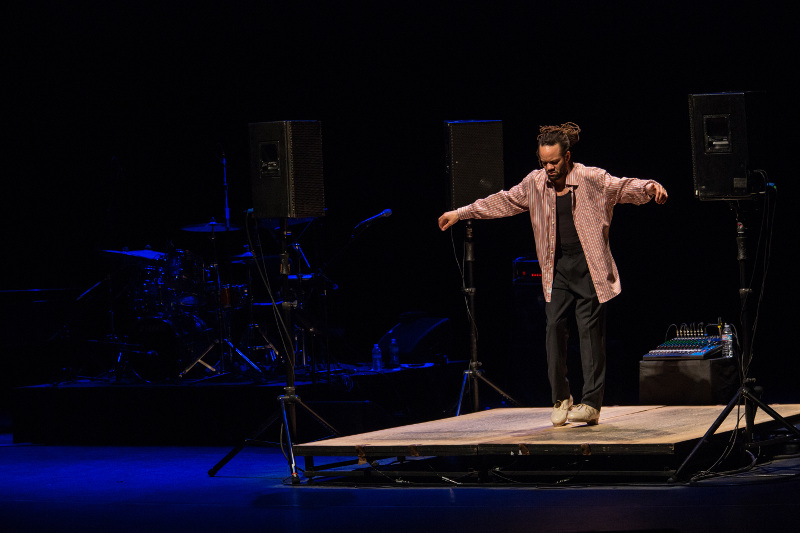
Ed. note: This story by Susan Reiter, commissioned and published by the Younes & Soraya Nazarian Center for the Arts, is reprinted with permission.
Savion Glover has been in the spotlight on stage and screen since an impossibly young age. In his third appearance at The Soraya, on October 7, the one-of-a-kind tap virtuoso brings his curiously entitled SoUNDz’ SaCRoSaNcT, which delves into his past along avenues of expression both timely and revealing. In shaping what he conceived as essentially a one-man show—one that pays homage to his influential mentors, particularly the inimitable Gregory Hines—Glover was drawn to the written word. The show is scripted. Two actors, sharing the stage with the dancer, provide the vocal soundtrack for the first portion of SoUNDz’ SaCRoSaNcT, and Glover’s refined, extended solo dance segments, in its second, respond to their words, backed by his three-piece music ensemble—two saxes and a string bass.
The deeply personal SoUNDz’ SaCRoSaNcT is still very new, evolving with each performance. The Soraya will be only the third venue where he’s performed it. His current plan is to take it on the road globally.
Discussing the show in a recent interview, Glover emphasizes his intention of guiding an audience toward a very pure, concentrated connection with tap—essentially, dance as sound. “My efforts are towards allowing the audience to hear the dance. As I thought about concepts and ways to entertain as well as educate, I found that I wanted to write, and create a different sort of background or setting for myself. Different than just myself and the quartet or band; different than myself and other dancers; different than myself and a Broadway production. I took the risk of creating something that I had never experienced before in a show, as an actor or as a dancer.”
He had worked with actors Kyle Wilson and Tatum Thompson on a previous program at the New Jersey Performing Arts Center. Knowing he would be writing a text, “I called them and started to write this story. I was trying to figure out how to do a one-man show—and this is my version of it. As I express myself through the dance, I’m sharing with people who love their craft—whether it’s art, music, haberdashery, anything. I think I am representing them, and their love of craft, in this show. At the same time, I’m exploring the boundary between self-expression and acknowledging my mentors along the way.”
The actors serve multiple purposes. They portray a doctor and student making a clinical examination of Glover’s life, and they also invoke the names of eminent tap dancers of the past with trenchant quotes that resonate with Glover. Names of tap-dance legends like Jimmy Slyde and Lon Chaney cause Glover to shift the style and approach of his dancing, inspired by the so-called Hoofers. But they are far more than just names. As a very young, eager tap dancer, Glover knew them, learned from them, and worked alongside them. Several were in the cast of Black and Blue, a memorably rich and illustrious 1989 Broadway revue. As young as he was, Glover understood the value these veterans could offer, and what they had to teach as dancers and exemplars of how to live one’s life. He says, “I know this sounds funny to say. But it wasn’t about tap dancing; it was about these guys. I felt like I had joined the track team and I needed to run, in order to be down with the guys. I was immediately drawn to them. I had a destiny with the future, and that future is old folk!”
Then there was Gregory Hines, Glover’s greatest influence who died in 2003, aged 57, of cancer. The two appeared together on Sesame Street and in the 1989 film Tap, which also featured many of Glover’s mentor-legends. In the 1992 Broadway musical Jelly’s Last Jam, with Hines as the conflicted, self-deluding Jelly Roll Morton and Glover portraying his younger self, they shared several thrilling tap sequences that propelled the show’s dark, deeply honest drama.
“I can count on one hand the men and women who I modeled my life after—Michael Jordan, John Coltrane and Gregory Hines,” he says with a rueful laugh. “I thought I was Gregory, for a very long time. I walked like him, talked like him, dressed like him, tried to be everything like him.”
Clearly Glover cannot over-emphasize Hines’s impact and influence. “He never appeared to be out of reach like a superstar. He came into my life immediately like a father figure. It wasn’t a show business relationship at all. I considered him one of my fathers, one of my teachers, one of my mentors, one of my closest relationships in this dance, and then in life, period. I learned – and continue to learn – so much from him.”
The honesty and self-examination of SoUNDz’ SaCRoSaNcT are not new to Glover. “I have never been part of a show that didn’t allow me to feel that I was telling my true story,” he admits. “My life is an open book as far as the stage goes. Every time I’m performing, I am sharing with an audience a piece of my life –very personal situations, personal development being shared with an audience. Coming through dance, it’s real.”
SoUNDz’ SaCRoSaNcT | Savion Glover | The Soraya | Oct 7
Susan Reiter is a New York-based arts journalist who covers dance for TDF Stages and contributes to Dance Australia, Playbill and many other publications.
